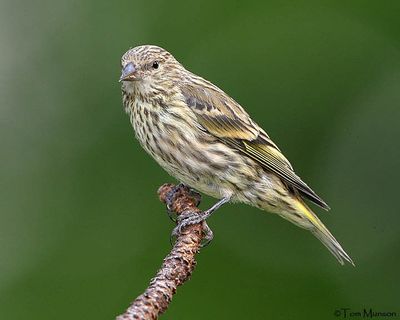Disease killing songbirds throughout the region

A recent outbreak of salmonellosis is leading to the deaths of wild birds throughout the northern United States.
The current die-off of finches such as pine siskins as well as other songbirds has been connected to the usually fatal bird disease caused by salmonella bacteria.
In an effort to control the spread of the disease, the state Department of Fish & Wildlife recommends the feeding of wild birds be discontinued until at least February or that extra steps be taken to maintain their feeders.
Fish & Wildlife is asking the public to report dead birds on its website.
“So many people feed birds,” said Skagit Audubon Society member Tim Manns. “And I myself have seen some birds that are ill, siskins in particularly.
“I have stopped feeding and have taken all my bird feeders down because of this. I have had other friends who have contacted me who have seen ill pine siskins. This salmonellosis is apparently very contagious, so they can catch it when they congregate at the same place.”
Manns said the outbreak could have been exacerbated by what’s called an irruption of finches taking place this winter.
“An irruption is when, because of such things as say the pine cone crop fails in the far north, rather than staying north where they breed, siskins come south looking for food,” he said.
Manns said he doesn’t remember the last time such an event happened in this area.
So, what should birders be looking for?
“The first indication of the disease for bird watchers to look for is often a seemingly tame bird on or near a feeder,” Fish & Wildlife veterinarian Kristin Mansfield said in a news release. “The birds become very lethargic, fluff out their feathers, and are easy to approach. This kind of behavior is generally uncommon to birds.
“Unfortunately, at this point there is very little people can do to treat them. The best course is to leave the birds alone.”
Manns said there is plenty of natural food in the area for wild birds and they don’t need to be fed through bird feeders in order to survive.
While rare, it is possible for salmonella bacteria to transfer from birds to humans through direct contact with infected birds, bird droppings, or through domestic cats catching sick birds, according to a Fish & Wildlife news release.
While avoiding the handling of dead birds is the best course of action, when not possible – or when handling bird feeders or bird baths – it’s best to wear gloves and wash hands thoroughly afterward, said Fish & Wildlife.
Those who continue wild bird feeding are encouraged to clean feeders daily by first rinsing the feeder with warm soapy water, then dunking in a solution of nine parts water and one part bleach. Finish by rinsing and drying before refilling, according to the release.
Keep the ground below the feeder clean by raking or shoveling up feces and seed casings, said Fish & Wildlife.
People are also asked to reduce the number of feeders they offer to a quantity they can maintain with daily cleanings, use feeders that accommodate fewer birds (such as tubes rather than platforms), spread out feeder locations and keep bird baths and fountains clean, according to the release.